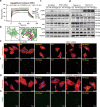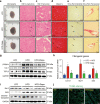Direct cardio-protection of Dapagliflozin against obesity-related cardiomyopathy via NHE1/MAPK signaling
- PMID: 35217813
- PMCID: PMC9525284
- DOI: 10.1038/s41401-022-00885-8
Direct cardio-protection of Dapagliflozin against obesity-related cardiomyopathy via NHE1/MAPK signaling
Abstract
Obesity is an important independent risk factor for cardiovascular diseases, remaining an important health concern worldwide. Evidence shows that saturated fatty acid-induced inflammation in cardiomyocytes contributes to obesity-related cardiomyopathy. Dapagliflozin (Dapa), a selective SGLT2 inhibitor, exerts a favorable preventive activity in heart failure. In this study, we investigated the protective effect of Dapa against cardiomyopathy caused by high fat diet-induced obesity in vitro and in vivo. Cultured rat cardiomyocyte H9c2 cells were pretreated with Dapa (1, 2.5 μM) for 1.5 h, followed by treatment with palmitic acid (PA, 200 μM) for 24 h. We showed that Dapa pretreatment concentration-dependently attenuated PA-induced cell hypertrophy, fibrosis and apoptosis. Transcriptome analysis revealed that inhibition of PA-activated MAPK/AP-1 pathway contributed to the protective effect of Dapa in H9c2 cells, and this was confirmed by anti-p-cJUN fluorescence staining assay. Using surface plasmon resonance analysis we found the direct binding of Dapa with NHE1. Gain and loss of function experiments further demonstrated the role of NHE1 in the protection of Dapa. In vivo experiments were conducted in mice fed a high fat diet for 5 months. The mice were administered Dapa (1 mg·kg-1·d-1, i.g.) in the last 2 months. Dapa administration significantly reduced the body weight and improved the serum lipid profiles. Dapa administration also alleviated HFD-induced cardiac dysfunction and cardiac aberrant remodeling via inhibiting MAPK/AP-1 pathway and ameliorating cardiac inflammation. In conclusion, Dapa exerts a direct protective effect against saturated fatty acid-induced cardiomyocyte injury in addition to the lowering effect on serum lipids. The protective effect results from negative regulating MAPK/AP-1 pathway in a NHE1-dependent way. The current study highlights the potential of clinical use of Dapa in the prevention of obesity-related cardiac dysfunction.
Keywords: Dapagliflozin; MAPK pathway; NHE1; cardiomyopathy; inflammation; obesity; palmitic acid; rat cardiomyocyte H9c2 cell line.
© 2022. The Author(s), under exclusive licence to Shanghai Institute of Materia Medica, Chinese Academy of Sciences and Chinese Pharmacological Society.
Conflict of interest statement
The authors declare no competing interests.
Figures







Similar articles
-
Dapagliflozin mitigates cellular stress and inflammation through PI3K/AKT pathway modulation in cardiomyocytes, aortic endothelial cells, and stem cell-derived β cells.Cardiovasc Diabetol. 2024 Oct 29;23(1):388. doi: 10.1186/s12933-024-02481-y. Cardiovasc Diabetol. 2024. PMID: 39472869 Free PMC article.
-
Dapagliflozin alleviates high-fat-induced obesity cardiomyopathy by inhibiting ferroptosis.ESC Heart Fail. 2025 Apr;12(2):1358-1373. doi: 10.1002/ehf2.15150. Epub 2024 Nov 11. ESC Heart Fail. 2025. PMID: 39523867 Free PMC article.
-
ALDH2 mediates the effects of sodium-glucose cotransporter 2 inhibitors (SGLT2i) on improving cardiac remodeling.Cardiovasc Diabetol. 2024 Oct 26;23(1):380. doi: 10.1186/s12933-024-02477-8. Cardiovasc Diabetol. 2024. PMID: 39462342 Free PMC article.
-
SGLT2 inhibitor dapagliflozin attenuates cardiac fibrosis and inflammation by reverting the HIF-2α signaling pathway in arrhythmogenic cardiomyopathy.FASEB J. 2022 Jul;36(7):e22410. doi: 10.1096/fj.202200243R. FASEB J. 2022. PMID: 35713937
-
Dapagliflozin Attenuates Cardiac Remodeling in Mice Model of Cardiac Pressure Overload.Am J Hypertens. 2019 Apr 22;32(5):452-459. doi: 10.1093/ajh/hpz016. Am J Hypertens. 2019. PMID: 30689697
Cited by
-
Rhein alleviates hepatic steatosis in NAFLD mice by activating the AMPK/ACC/SREBP1 pathway to enhance lipid metabolism.Mol Med. 2025 Jul 10;31(1):255. doi: 10.1186/s10020-025-01304-4. Mol Med. 2025. PMID: 40640749 Free PMC article.
-
Heart failure with preserved ejection fraction and obesity: emerging metabolic therapeutic strategies.Diabetol Metab Syndr. 2025 Aug 18;17(1):336. doi: 10.1186/s13098-025-01917-z. Diabetol Metab Syndr. 2025. PMID: 40826119 Free PMC article. Review.
-
14-Deoxygarcinol improves insulin sensitivity in high-fat diet-induced obese mice via mitigating NF-κB/Sirtuin 2-NLRP3-mediated adipose tissue remodeling.Acta Pharmacol Sin. 2023 Feb;44(2):434-445. doi: 10.1038/s41401-022-00958-8. Epub 2022 Aug 9. Acta Pharmacol Sin. 2023. PMID: 35945312 Free PMC article.
-
Dapagliflozin targets SGLT2/SIRT1 signaling to attenuate the osteogenic transdifferentiation of vascular smooth muscle cells.Cell Mol Life Sci. 2024 Nov 9;81(1):448. doi: 10.1007/s00018-024-05486-8. Cell Mol Life Sci. 2024. PMID: 39520538 Free PMC article.
-
The SGLT2 inhibitor empagliflozin inhibits skeletal muscle fibrosis in naturally aging male mice through the AMPKα/MMP9/TGF-β1/Smad pathway.Biogerontology. 2024 Jun;25(3):567-581. doi: 10.1007/s10522-024-10093-y. Epub 2024 Feb 26. Biogerontology. 2024. PMID: 38403802
References
-
- Schaeffler A, Gross P, Buettner R, Bollheimer C, Buechler C, Neumeier M, et al. Fatty acid-induced induction of Toll-like receptor-4/nuclear factor-kappaB pathway in adipocytes links nutritional signalling with innate immunity. Immunology. 2009;126:233–45. doi: 10.1111/j.1365-2567.2008.02892.x. - DOI - PMC - PubMed
MeSH terms
Substances
LinkOut - more resources
Full Text Sources
Medical
Miscellaneous

